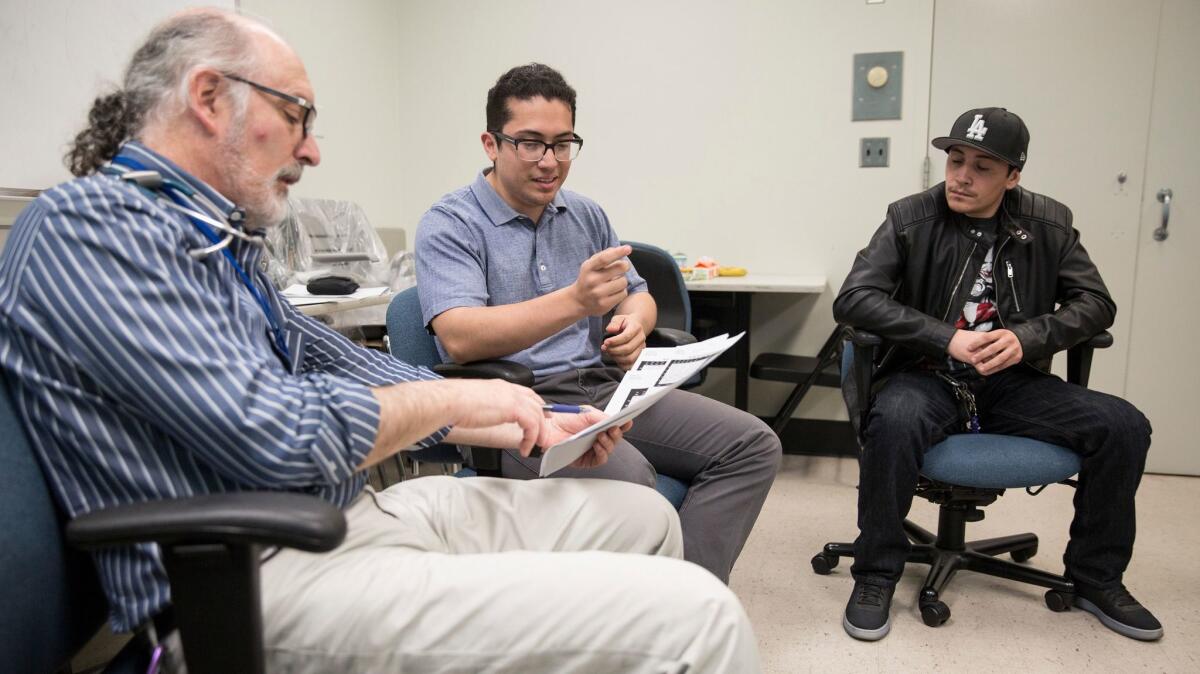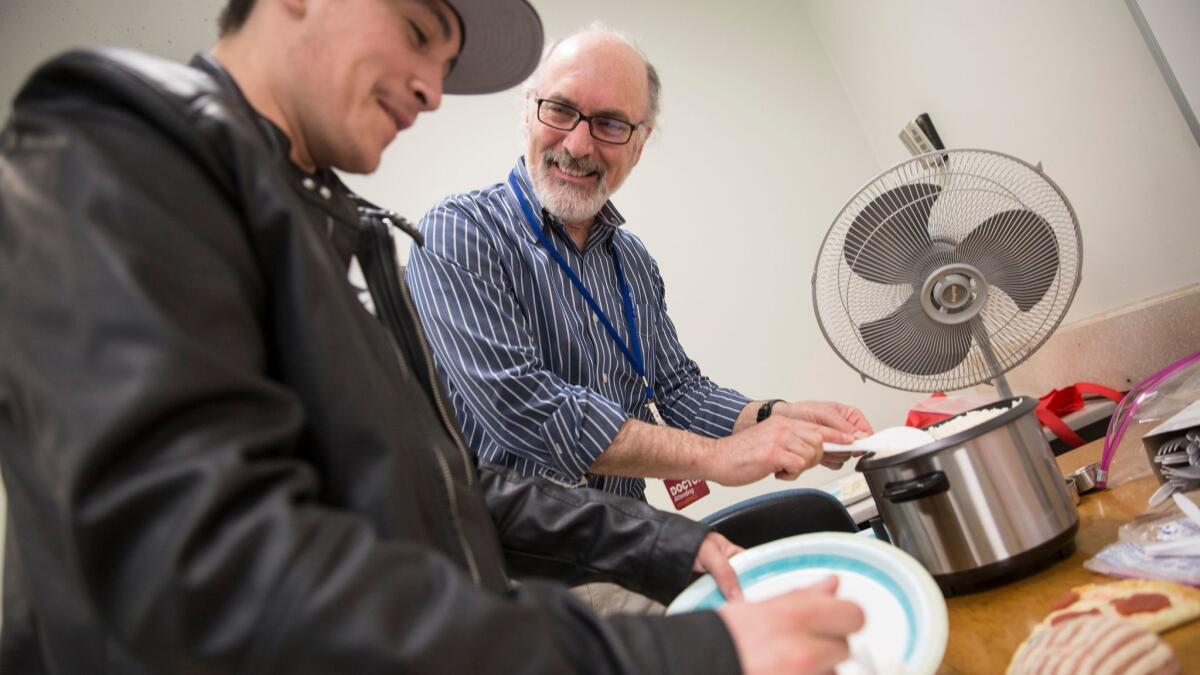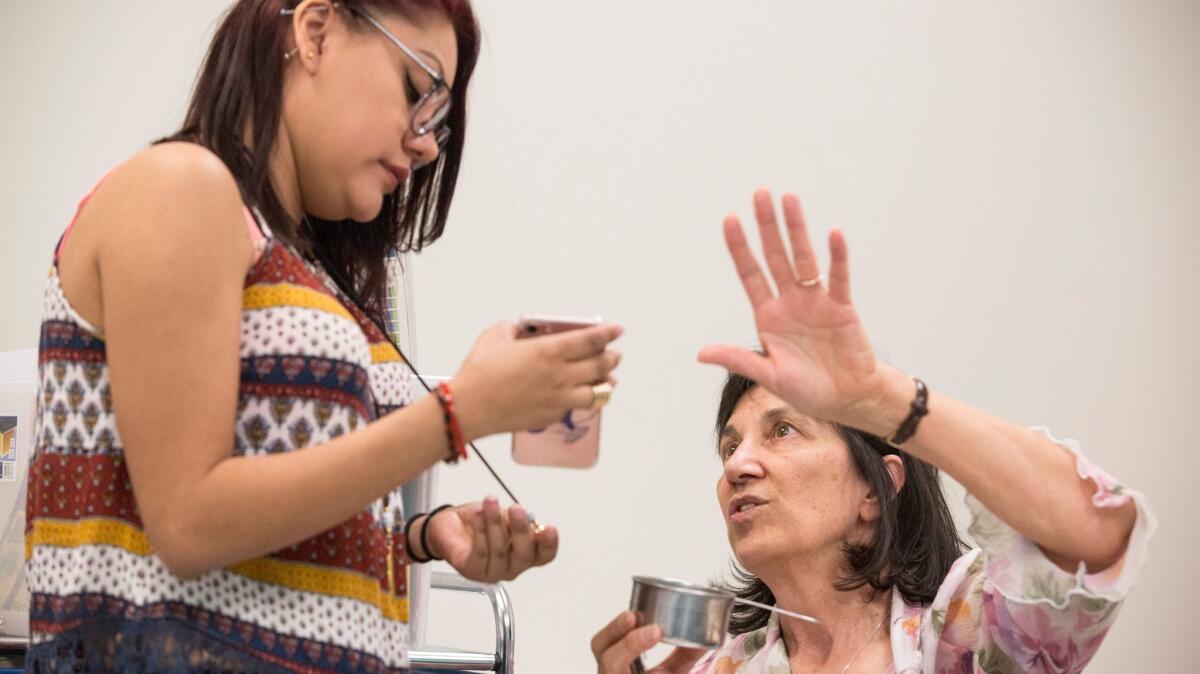Doctors turn to the power of peer groups to help diabetics

- Share via
Dr. Marc Weigensberg was having trouble getting his younger diabetes patients to listen to him. He’d repeat advice, but often they’d tune him out. He couldn’t get them to open up.
So he decided he might have better luck making them share with someone else: each other.
About a year ago, Weigensberg began leading two-hour group visits with a dozen young adults at Los Angeles County-USC Medical Center to provide them with a place to share tips for living with diabetes and talk about their experiences and problems with the disease.
On a recent Friday, a handful of patients sat in a circle with Weigensberg in a small room at the Boyle Heights hospital, passing around a kaleidoscope — only the person holding it can speak. Weigensberg, who has a soothing voice and a silver ponytail, checked in on each of them individually; he knows that injecting insulin several times a day and closely monitoring every meal can be exhausting.
“Sometimes it gets to me,” said Gabriel Leon, 26, who has had diabetes for two decades. “At night, it’s like, ‘I have to do this again?’ ”
Group visits aren’t new, but they’re gaining traction as health systems look for more efficient ways to treat patients. Plus, such gatherings often focus on things like diet, exercise and self-care, which increasingly are recognized as essential parts of not only preventing diseases but also living with them.
The injections are only a small part of coping with the disease
Only 10% of managing diabetes is learning how to inject insulin and check sugars. The other 90% is trying to “integrate such an intrusive chronic disease into their life,” said Weigensberg, a pediatric endocrinologist. And that’s why it’s not doctors, but people with the condition who might best explain how to do that.
“We’re experts in diabetes, but we’re not experts in your diabetes,” Weigensberg said at the recent appointment.
The patients signed up for Weigensberg’s group visits have Type 1 diabetes, meaning their bodies stopped making insulin when they were children. They have to inject themselves with the hormone that breaks down sugar so their bodies can turn carbohydrates into energy. To do that correctly, they need to know the number of carbohydrates in everything they eat.
Geri Zwicker, a hospital nutritionist, joined the recent meeting to suggest ways to eyeball carbohydrate servings. She recommended the patients help set the table for meals and serving food themselves, so they can count and maybe even measure how much they eat. But she knows that’s difficult at restaurants or parties, so it’s important to be able to estimate.

Fabio Lara, 21, opened a rice cooker Zwicker had brought, releasing steam and the smell of fresh rice into the room. Zwicker told him to scoop about as much as he’d normally eat onto a plate. The mound of white rice, a little over a cup, has 50 grams of carbohydrates, so he can assume that’s how much he normally eats for dinner, Zwicker said.
Weigensberg doesn’t yet have data from the visits, but other studies have found that diabetic patients seen in group environments have lower hospitalization rates and better control over their disease.
Getting over the hurdle of caring about what others think
The doctor recalled a satisfying moment during one session, when a college student said he wasn’t checking his sugar levels at lunch because he didn’t want to poke himself at school. Another boy then said he does it anyway because he doesn’t care what strangers might think. The next time the group met, the reluctant patient had started testing his sugars.
“That simple thing can make a huge difference,” Weigensberg said. “You don’t really know what or when will trigger a new behavior; you just gotta let go of the fact that you can’t do everything.”
Weigensberg suggests topics to discuss each month but allows the participants to refocus the conversation based on what’s bothering them.
“Community itself is a healing force … and by healing, I don’t mean curing; I mean being more at ease with their illness,” he said.
People with chronic conditions sometimes feel isolated or ashamed because their body does not work like everyone else’s, said Kathleen Ulman, an assistant professor of psychiatry at Harvard Medical School. Group visits offer the comfort of a shared experience, she said.
“People don’t feel alone anymore, and that is really worth a lot,” she said. “You become connected with each other and identify with each other, and if one person makes some improvement, then you’ll feel like, ‘Well I could do it, if they could do it.’ ”
Community itself is a healing force … and by healing, I don’t mean curing; I mean being more at ease with their illness.
— Dr. Marc Weigensberg, pediatric endocrinologist
The issues that tend to surface in group gatherings, like transportation to doctors’ appointments or the cost of medicine, aren’t medical issues per se, but social issues that affect patients’ medical problems.
But more and more, “those boundaries seem to be blurring because so many chronic diseases have lifestyle issues tied to them,” said Sherrie Kaplan, assistant vice chancellor for Healthcare Measurement and Evaluation in the UC Irvine School of Medicine.
And since doctors might not always be in tune with these concerns, Kaplan and her colleagues started a program at UC Irvine in which they coach patients to bring up hurdles with doctors. So-called coaches nab patients in the waiting room and talk through their treatment before they meet with their doctor.
Among the concerns: “I can’t afford my medications. ... My mother-in-law cooks the meals, but then she gets upset if I don’t want to eat what she serves,” Kaplan said.
She’s found the program dramatically reduces how often patients miss appointments and end up in the emergency room.
Sometimes a 15-minute doctor’s visit doesn’t get the job done
The national Agency for Healthcare Research and Quality, a branch of the U.S. Department of Health and Human Services, recommends group visits as a way to address patient concerns that might not be covered in a 15-minute doctor’s visit.

At Weigensberg’s group visit, Cynthia Sanchez, 21, pulled up a photo on her smartphone of a dish her mom makes — rice mixed with potatoes, corn, hard-boiled eggs, mayonnaise chicken and shrimp.
Sanchez doesn’t know how much insulin to take when she eats it because she isn’t sure how many carbohydrates are in it. She passed around the photo, and everyone tried to guess how much was carbs.
Weigensberg suggested she take an insulin dose she thinks might be appropriate, eat the meal and then check her blood sugar levels three hours later to see if her guess was correct.
“Then you’ll know if you underdid it or overdid it,” he said. “You can do that with any food.”
At the end of Weigensberg’s visit, he asked all those in the group to close their eyes. “Let your focus dim,” he said softly.
Sanchez removed her glasses and tilted her head back slightly. Leon leaned forward to rest his forearms on his thighs, and clasped his hands.
Weigensberg asked them to imagine eating their next meal, perhaps in a kitchen or a restaurant. Then imagine preparing the insulin injection, he said.
Afterward, he asked them how they felt. Anxious? Stressed?
Hungry, they said. It’s lunchtime.
soumya.karlamangla@latimes.com
Twitter: @skarlamangla
ALSO
You know CPR. Now firefighters want you to treat shooting and bombing victims
Vaccination rate jumps in California after tougher inoculation law
Under fire from hospitals, legislator drops measure requiring reports of superbug deaths
More to Read
Sign up for Essential California
The most important California stories and recommendations in your inbox every morning.
You may occasionally receive promotional content from the Los Angeles Times.











